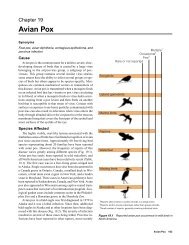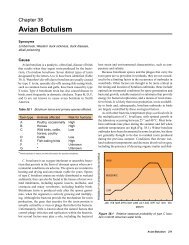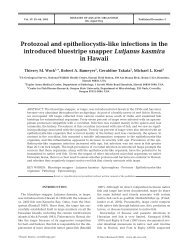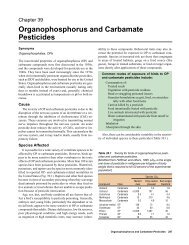Biowarfare, Bioterrorism, and Animal Diseases as Bioweapons
Biowarfare, Bioterrorism, and Animal Diseases as Bioweapons
Biowarfare, Bioterrorism, and Animal Diseases as Bioweapons
Create successful ePaper yourself
Turn your PDF publications into a flip-book with our unique Google optimized e-Paper software.
Box 6–1<br />
See No Evil, Hear No Evil, Speak No Evil<br />
“Russia h<strong>as</strong>…never developed, produced, accumulated, or stored<br />
biological weapons.”—Address by Grigory Berdennikov, head of Russian<br />
delegation to a November 1996 conference of signatories to the 1972<br />
Biological Weapons Convention 26<br />
Cat<strong>as</strong>trophic events often result in b<strong>as</strong>ic questions being <strong>as</strong>ked. Why did this happen?<br />
Could this have been prevented? Should we have been better prepared? These<br />
<strong>and</strong> other questions clearly apply to bioterrorism. Inadequate levels of preparedness<br />
are in part reflections of problem denial <strong>and</strong> other priorities within national policy<br />
circles, <strong>and</strong> the belief that open dialogue in this subject area should be avoided so<br />
that potential perpetrators would not be enticed to pursue such actions. 32 In essence,<br />
p<strong>as</strong>t approaches to the issues of bioterrorism have generally followed the first two<br />
components of the adage “See No Evil, Hear No Evil, Speak No Evil;” while at the<br />
same time, some nations were undertaking the development of biological weapons<br />
for defensive purposes.<br />
Microbes <strong>as</strong> Weapons<br />
Biological weapons, or bioweapons, are those containing<br />
replicating microorganisms (viruses, fungi, <strong>and</strong> bacteria,<br />
including chlamydia <strong>and</strong> rickettsia), prions, protozoa, or<br />
238 Dise<strong>as</strong>e Emergence <strong>and</strong> Resurgence: The Wildlife–Human Connection<br />
poisonous chemical toxins produced by living organisms<br />
(e.g., botulinum toxin, cobra venom, <strong>and</strong> the plant toxin,<br />
ricin). 139 Depending on the pathogen being used, these<br />
weapons may be employed against humans, animals, or<br />
crops. 110,140 In some instances, multiple species groups<br />
Table A. Examples of current publications dealing with biowarfare <strong>and</strong>/or bioterrorism. a<br />
Title Content<br />
Biological <strong>and</strong> Toxin Weapons: Research, Development <strong>and</strong><br />
Use from the Middle Ages to 1945 14<br />
<strong>Bioterrorism</strong> <strong>and</strong> Public Health: An Internet Resource<br />
Guide 204<br />
PDR Guide to Biological <strong>and</strong> Chemical Warfare<br />
Response 205<br />
<strong>Bioterrorism</strong>: Guidelines for Medical <strong>and</strong> Public Health<br />
Management 49<br />
When Every Moment Counts: What You Need to Know About<br />
<strong>Bioterrorism</strong> from the Senate’s Only Doctor 27<br />
Terrorism <strong>and</strong> Public Health: a Balanced Approach to<br />
Strengthening Systems <strong>and</strong> Protecting People 177<br />
Factories of Death: Japanese Biological Warfare, 1932–1945,<br />
<strong>and</strong> the American Cover-up 23<br />
Biohazard: the Chilling True Story of the Largest Covert Biological<br />
Weapons Program in the World, Told from the Inside<br />
by the Man Who Ran it 26<br />
Publication title indicates content.<br />
An Internet resource guide to a wide range of Web-b<strong>as</strong>ed<br />
resources; b<strong>as</strong>ic information also included <strong>as</strong> text.<br />
Signs, symptoms, <strong>and</strong> recommended treatments for over 50<br />
biological <strong>and</strong> chemical agents.<br />
Compilations of consensus statements from the Working<br />
Group on Civilian Biodefense, anthrax c<strong>as</strong>e reports, <strong>and</strong><br />
intervention analysis.<br />
Questions <strong>and</strong> answers about anthrax, smallpox, plague,<br />
botulism, tularemia, Ebola, other viral hemorrhagic fevers,<br />
<strong>and</strong> other relevant subject are<strong>as</strong>.<br />
Organized under main subject are<strong>as</strong> of The Public Health<br />
Response to September 11 <strong>and</strong> Its Aftermath, Terrorist<br />
Weapons, Challenges <strong>and</strong> Opportunities.<br />
Comprehensive account of the Japanese biological warfare<br />
program (experimental <strong>and</strong> field applications) from<br />
1932–1945.<br />
Personal account of the biological weapons program of the<br />
former USSR by the leader of that program.<br />
Secret Agents: The Menace of Emerging Infections 206 Primary focus is on the emergence of infectious dise<strong>as</strong>e but<br />
contains a major chapter on the evolution of bioterrorism.<br />
a These examples are not considered of greater value than other publications in this subject area.

















